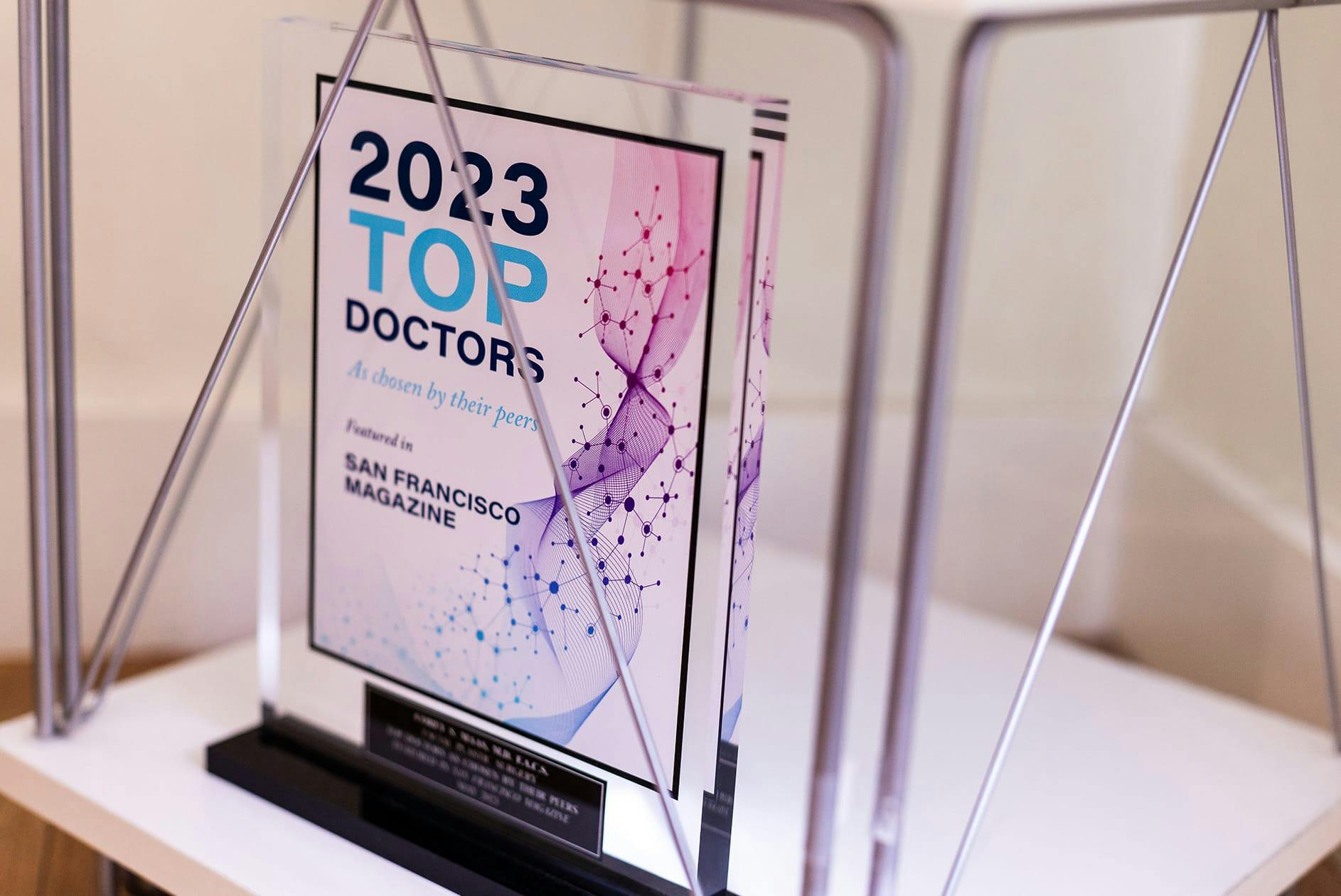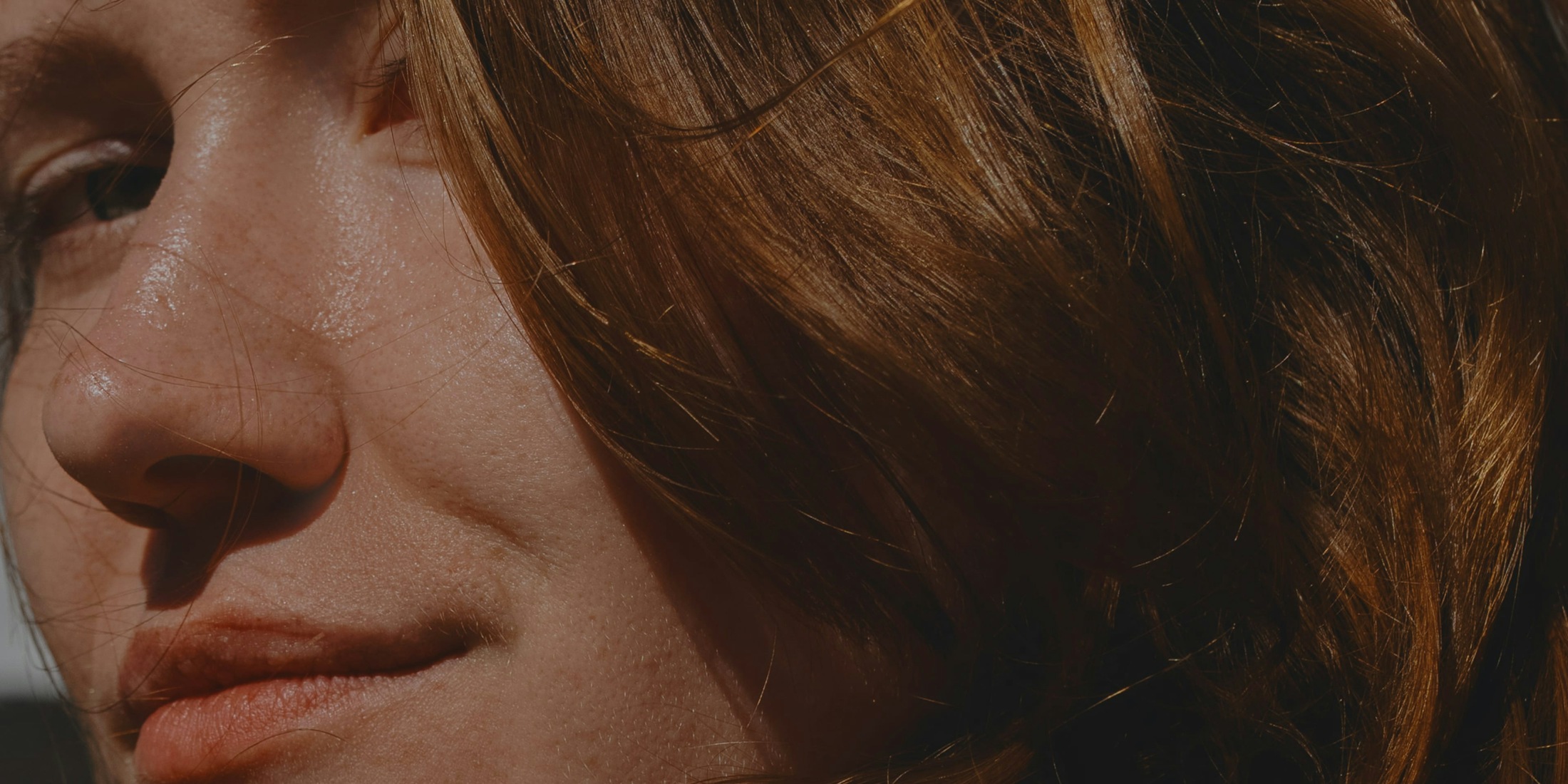
Eugene J. Kim, MD & Corey S. Maas, MD
Pathogenesis of Facial Aging
Facial aging generally consists of intrinsic and extrinsic processes. Intrinsically, the most extensive changes occur in the dermis, especially in its upper third. The total amount of ground substance, predominantly made of glycosaminoglycans and proteoglycans, diminishes. In addition, elastic fibers, which maintain the wavy pattern of collagen bundles, become thin and fragmented with time, beginning at the age of 30. Finally, the ratio of type I to type III collagen diminishes over time, along with a general reduction in the total amount of collagen.
Extrinsically, one of the main factors in facial aging is from actinic damage. In a process called elastosis, collagen is degraded and elastin is increased. The dermis becomes thickened and poorly organized. Fine-skin wrinkling from sun-damaged epidermis also occurs. Along with fat atrophy in the subcutaneous tissue, there is a general redistribution of tissue due to gravitational effects. The sagging of tissue leads to the loss of the cervicomental angle and mandibular definition. All these factors contribute to the aging face.
Anatomy
Superficial Musculoaponeurotic System
Anatomic studies have shown the superficial musculoaponeurotic system (SMAS) to be a distinct layer that is just superficial to and closely applied to the parotid fascia (Figure 71–1). Generally, sensory nerves lie superficial and facial nerve fibers lie deep to the SMAS. Superiorly, the SMAS is contiguous with the temporoparietal fascia. Anteriorly, insertion occurs at the lateral border of the zygomaticus muscle and to the dermis of the upper lip. Thus, the posterior traction of the SMAS will actually deepen the nasolabial fold. The SMAS is also in continuity with the orbicularis oculi muscle in the lower eyelid. Inferiorly, there is continuity with the platysma over the body of the mandible and extension in the neck.
Platysma
The platysma is a broad, thin muscle innervated by the cervical branch of the facial nerve. It has been shown to have different configurations in terms of midline decussation. This has implications in the aging face in that platysmal bands can form along with the pseudoherniation of fat. This results in the “turkey gobbler” look and the loss of the cervicomental angle, which contributes to an aged appearance.
Facial Nerve
The facial nerve (cranial nerve VII) gives mimetic function through innervation of the facial musculature. Divisions include the frontal, zygomatic, buccal, mandibular, and cervical branches (Figure 71–2). Crossover innervation occurs up to 70% in the zygomatic and buccal branches and only up to 15% in the frontal and mandibular branches. The frontal branch runs within the temporoparietal fascia and lies just superficial to the superficial layer of the deep temporal fascia. It generally crosses the zygoma approximately 4 cm lateral to the lateral canthus. The zygomatic and buccal branches are deep to the SMAS but become more superficial as they course anteriorly. The marginal branch has a varying course but generally extends up to 1 cm below the inferior edge of the mandible.
Greater Auricular Nerve
The greater auricular nerve provides sensation to the inferior lobule and the upper neck and is a branch of the cervical plexus. The skin and SMAS lie just superficial to the nerve. The nerve has an intimate association with the sternocleidomastoid muscle and has been shown to cross the muscle at its midpoint, approximately 6 cm below the external auditory canal.
Patient Selection
The appropriate selection of patients has critical importance in assuring a desirable outcome. Patients need to understand the goals and limitations of rhytidectomy. They should be motivated and should be willing to participate in other associated changes that support longevity, such as improved diet, smoking cessation, and sun protection. An ideal patient is a healthy, motivated individual aged 40 to 60 whose skin has some elasticity without severe solar damage, and who is an appropriate weight. The major concern should be of ptotic skin and muscle.
Patients often inquire as to the “length” their facelifts will last. They should be made aware that rhytidectomy will not stop the aging process but rather give them a more youthful appearance from which they will continue to age. This process will be dictated by their individual genetic predisposition and somewhat by their environment. Multiple consultations may be necessary and should be encouraged if there seem to be any hidden motivations or confusion about the goals of the procedure. Cooperation by patients is critical in their postoperative recovery and it behooves the surgeon to devote equal effort to the selection process as much as to the operation itself.
Patient History & Physical Examination
Preparation for surgery should include a complete history and physical examination. Any history of bleeding problems should alert the physician that a hematologic workup may be necessary. This has obvious implications with regard to a postoperative risk of hematoma. The appropriate control of any medical problems, most importantly hypertension, should be assured. Patients should cease smoking and the use of nonsteroidal anti-inflammatory medications approximately 2 weeks prior to and after surgery.
At the time of the preoperative visit, the procedure should be reviewed, informed consent obtained, and any final questions answered. Preoperative photographs are mandatory and are taken in the standard lateral, oblique, and frontal views.
Preoperative Preparation & Anesthesia
In the preoperative area, the patient’s hair is carefully combed along planned incision lines and rubber bands are applied as twist ties. By twisting the hair in the area of the planned incision sites, hair loss is minimized.
Some surgeons perform rhytidectomy using local anesthesia with sedation. However, the use of general anesthesia is preferred by many others to maximize patient comfort. It also allows the surgeon to concentrate on the operative field and not have his or her attention distracted by monitoring the patient’s vital signs and status. A smooth extubation should be a high priority to decrease the risk of hematoma.
Following the induction of general anesthesia, an endotracheal tube is fixed in the midline, taking care not to distort the facial anatomy. The first side is infiltrated with 1% lidocaine with 1:100,000 epinephrine along the skin incisions and widely across the planned area of elevation. Adequate local anesthetic is critical in minimizing bleeding during skin flap elevation through the vasoconstrictive effects of epinephrine. The contralateral side is injected while completing the first side to maximize hemostasis and minimize toxicity. Prior to the administration of anesthesia, care should be taken to calculate the maximal dose, which is based on body weight.
Surgical Techniques
Incisions
The placement of incisions is important and influenced by several factors. The principal goals are to minimize hair loss, hairline adjustments, visible scars, and changes in normal anatomic structures. In general, incisions should be placed post-tragal in women and pre-tragal in men. Pretragal incisions avoid the need to redrape hair-bearing skin onto the tragus. As the incision is carried superiorly past the helical root, careful attention should be made to preserving the temporal hair tuft and preventing alopecia in this area. If the temporal area requires lifting, the incision is curved anterosuperiorly into the hair-bearing scalp. If alopecia is a concern, the incision is brought more anteriorly in a pretrichial or “trichophytic” fashion to preserve the patient’s hairline (Figure 71–3). The incision is also made irregularly to help camouflage the scar.
The posterior incision is preferably brought into the hair. The alternative to bringing the posterior incision along the hairline can result in visible scar tissue from scar widening. The postauricular incision is brought within 1–2 cm of the sulcus, with a 90° posterior turn into the hair above the external auditory canal. It extends approximately 6–8 cm posteriorly, with a 45° downturn at the end. This helps prevent a standing cutaneous deformity during flap advancement.
Subcutaneous Rhytidectomy
Subcutaneous flap techniques have an extremely low risk of facial nerve injury and remain in common use. The flap is elevated with facelift scissors just superficial to the SMAS using a combination of traction and countertraction (Figure 71–4). Elevation of the flap into the neck extends to the middle third of the neck. Undermining in the neck is carried anteriorly to the midline, and the physician should always be mindful of staying superficial and using blunt dissection. Care must be taken in dissection around the sternocleidomastoid to avoid injury to the greater auricular nerve and the external jugular vein. The extent of the anterior dissection depends on the individual patient. Once the anterior border of the parotid gland is reached, the risk of facial nerve injury increases. Superiorly, dissection is carried in a plane superficial to the temporalis fascia, which allows the protection of the frontal facial nerve branch.
In general, skin flap length is dictated by the surgeon’s experience and each individual case. The risks of hematoma, skin flap ischemia, and facial nerve injury obviously increase in longer skin flaps. In patients who may be at risk for skin flap ischemia (ie, smokers) a shorter skin flap may be desirable. Meticulous hemostasis of the skin flap is made with bipolar electrocautery to prevent facial nerve injury. The use of a lighted retractor can help in visualizing bleeding sites, especially with longer skin flaps.
Sub-SMAS Rhytidectomy
Techniques that address the SMAS-platysma complex have been shown to have more favorable long-term results as compared to skin flap elevation alone. There are many described methods of dealing with the SMAS. Suture plication or the infolding of the SMAS allows for the placement of tension without the need to incise the SMAS, which places the facial nerve at a slightly greater risk of injury. However, the elevation of a SMAS flap may allow for a superior result with a skilled surgeon. The SMAS is incised in the preauricular and neck regions and elevated using blunt dissection. The limits of the flap are just below the zygomatic arch superiorly, the anterior border of the parotid gland anteriorly, and the angle of the mandible inferiorly (Figure 71–5). Facial nerve fibers may be visible and extreme care is taken to preserve them. After the excision of excess tissue, a nonabsorbable suture is used to suspend this flap in a posterosuperior direction to the mastoid periosteum and temporal fascia (Figure 71–6).
Deep-Plane & Composite Rhytidectomy
Deep-plane rhytidectomy attempts to address aging changes in the melolabial fold and malar area. According to advocates of this procedure, these are areas that are not directly addressed with simple SMAS-platysma suspension techniques. Composite rhytidectomy essentially extends the deep plane by including the orbicularis oculi muscle in the dissection. Essentially, a composite flap is created, which is preplatysmal in the neck, suborbicularis oculi in the malar regions, and sub-SMAS anterior to the cheek fat pad. Anteriorly, the investing fascia is released from the zygomaticus major muscle. The composite flap is then suspended in one unit (Figure 71–7). The added risk in this dissection relates to the facial nerve. More specifically, the zygomatic branch and facial nerve branches innervating the orbicularis oculi muscle are at risk of injury. With experience and a detailed anatomic knowledge of the facial nerve branches in this area, the surgeon may achieve an improved result with this technique.
Closure & Drains
The direction of suspension for the skin flap is posterior and superior. Making the majority of the closure tension free is critical. The points of maximal tension are in the temporal and occipital regions and key sutures are placed to suspend the skin flap. Following suspension, excess skin is trimmed so that the skin edges are reapproximated in a tension-free manner. This is especially important at the lobule to prevent the “pixie ear” deformity that occurs when this area is placed under undue tension. This problem can be avoided by incising the skin flap so that the lobule rests in a neutral position without tension directed inferiorly.
The pretragal area is carefully defatted and a subcutaneous anchoring suture is placed to recreate the normal concave contour of this area. The preauricular and postauricular skin up to the hair-bearing skin is closed with interrupted or running sutures. The hair-bearing skin is closed with surgical clips. All wound edges are everted to minimize visible scarring.
Closed-suction drainage is placed through a separate stab incision in the hair-bearing skin. No studies show that drains actually help prevent hematomas. However, drains allow for the removal of residual fluid and help to keep the skin flap adherent to the underlying tissue. The use of tissue sealants that use fibrin, thrombin, or platelet-rich gel (or any combination of these substances) may obviate the need for drains.
Postoperative Care
The wounds are cleaned and antibiotic ointment is placed on the incisions. Bulky dressings are placed immediately following the procedure and help in keeping pressure on the skin flap. The head of the bed is kept elevated and patients are placed on limited bedrest. Blood pressure control with the patient’s normal medication, along with the control of pain and nausea, are extremely important in the immediate postoperative period. Unilateral pain or pain unresponsive to medication needs an immediate evaluation for the possibility of a hematoma. The drains and bulky dressings are removed on the first postoperative day. Elastic bandages or a light dressing are subsequently placed for comfort and support.
Incisions are cleaned with half-strength hydrogen peroxide and an antibiotic ointment is placed to keep the wounds moist and encourage wound healing. Suture removal occurs on postoperative day 5 or 7 and surgical clips are removed on day 10. Patients are reassured that postoperative edema and ecchymosis will resolve.
Complications
Nerve Injury
The most commonly injured nerve in rhytidectomy is the greater auricular nerve, with a 6% rate of injury. The nerve is intimately associated with the sternocleidomastoid muscle and the overlying skin, and can be easily injured during skin flap elevation. If transected, the nerve is reapproximated with fine suture.
Facial nerve injury is relatively rare and has been reported to be 2.6% with subcutaneous techniques and up to 4.3% in sub-SMAS techniques. The buccal branch of the facial nerve is the most commonly injured in rhytidectomy. However, because of overlapping innervation in the upper lip, it is the least noticed. Because of the minimal overlap, the marginal and frontal branches are at the greatest risk for permanent and obvious paralysis.
Hematoma
Hematoma is the most common complication of rhytidectomy and has a occurrence rate of 1–8%. Men are twice as prone to developing hematoma secondary to the increased vascularity in the hair-bearing skin of the face. Hematoma is a worrisome complication because of the risk of epidermolysis and skin slough. Symptoms and signs of hematoma include an abrupt increase in pain, swelling, and ecchymosis, which are especially concerning if they are unilateral. Rapidly expanding hematomas necessitate a return to the operating room and the control of bleeding points. With prompt management, significant sequelae can usually be avoided. When hematomas are delayed or small, they can be managed with needle aspiration and pressure dressings. The incidence of hematoma can be minimized with careful intraoperative hemostasis, blood pressure control, and the cessation of NSAIDs.
Additional Complications
Other complications of rhytidectomy include scarring, a “pixie ear” deformity, an elevated temporal hairline, and skin slough. These can be prevented by careful incision placement and minimizing tension on the suture line. Infection is a relatively rare complication of rhytidectomy and is treated with antibiotic therapy.
Baker D. Rhytidectomy with lateral SMASectomy. Facial Plast Surg. 2000;16(3):209. [PMID: 11802569] (Review of the SMAS excision technique.)
Baker DC, Conley J. Avoiding facial nerve injuries in rhytidectomy. Anatomical variations and pitfalls. Plast Reconstr Surg. 1979;64(6):781. [PMID: 515227] (A classic review of facial nerve anatomy in the context of rhytidectomy.)
Brennan HG, Toft KM, Dunham BP, Goode RL, Koch RJ. Prevention and correction of temporal hair loss in rhytidectomy. Plast Reconstr Surg. 1999;104(7):2219. [PMID: 11149791] (Review of decision making in approaching the temporal hair tuft.)
Grover R, Jones BM, Waterhouse N. The prevention of haematoma following rhytidectomy: a review of 1078 consecutive facelifts. Br J Plast Surg. 2001;54(6):481. [PMID: 11513508] (Retrospective analysis of the risk factors for hematoma.)
Hamra ST. The deep-plane rhytidectomy. Plast Reconstr Surg. 1990;86(1):53. [PMID: 2359803] (Classic article first describing the deep-plane rhytidectomy.)
Hamra ST. Composite rhytidectomy. Plast Reconstr Surg. 1992; 90(1):1. [PMID: 1615067] (Classic article first describing the composite rhytidectomy.)
Kamer FM. One hundred consecutive deep plane face-lifts. Arch Otolaryngol Head Neck Surg. 1996;122(1):17. [PMID: 8554742] (Prospective study of the deep-plane rhytidectomy.)
Kamer FM, Frankel AS. SMAS rhytidectomy versus deep plane rhytidectomy: an objective comparison. Plast Reconstr Surg. 1998;102(3):878. [PMID: 9727459] (Retrospective review that favors the deep-plane rhytidectomy.)
Larrabee WF Jr, Henderson JL. Face lift: the anatomic basis for a safe, long-lasting procedure. Facial Plast Surg. 2000;16(3): 239. [PMID: 11802572] (Anatomic review and its implications in successful rhytidectomy.)
McCollough EG, Perkins SW, Langsdon PR. SASMAS suspension rhytidectomy: rationale and long-term experience. Arch Otolaryngol Head Neck Surg. 1989;115(2):228. [PMID: 2643976] (A substantial retrospective review of the SMAS technique by an expert on rhytidectomy.)
Mitz V, Peyronie M. The superficial musculo-aponeurotic system (SMAS) in the parotid and cheek area. Plast Reconstr Surg. 1976;58(1):80. [PMID: 935283] (The classic article first describing the SMAS anatomically.)
Perkins SW, Williams JD, Macdonald K, Robinson EB. Prevention of seromas and hematomas after face-lift surgery with the use of postoperative vacuum drains. Arch Otolaryngol Head Neck Surg. 1997;123(7):743. [PMID: 9236595] (Retrospective review showing the effectiveness of drains in decreasing seroma and hematoma formation.)
Sherris DA, Larrabee WF Jr. Anatomic considerations in rhytidectomy. Facial Plast Surg. 1996;12(3):215. [PMID: 9243990] (Review article of relevant anatomy.)
Figure 71–1. The SMAS is a distinct layer between the parotid gland, skin, and subcutaneous fat.
Figure 71–2. Facial nerve anatomy.
Figure 71–3. Possible incisions in rhytidectomy.
Figure 71–4. Elevation of the skin flap in the subcutaneous plane.
Figure 71–5. Incision of the SMAS.
Figure 71–6. Suspension of the SMAS superiorly and posteriorly.
Figure 71–7. Composite rhytidectomy with dissection of the orbicularis oculi and zygomaticus muscles.



